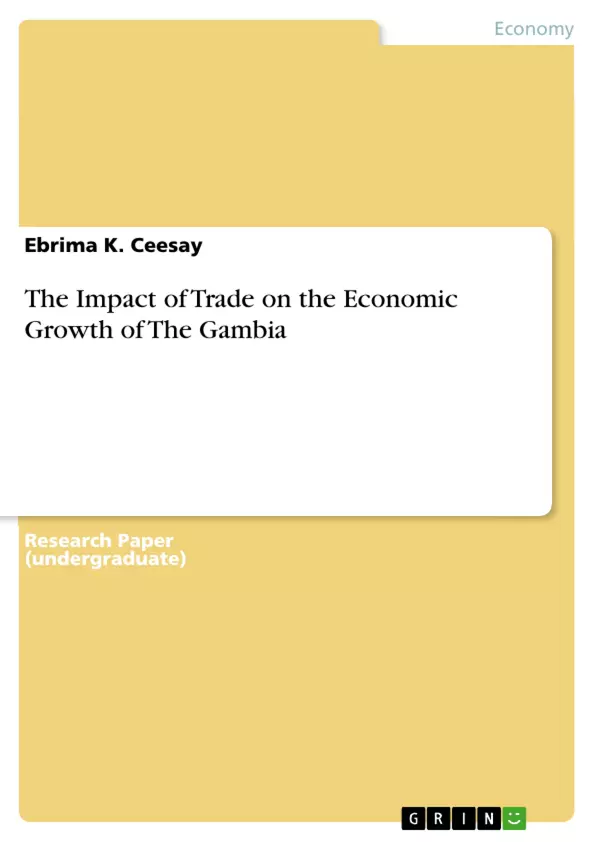The study examined the general impact of trade on economic growth in the Gambia from 1965 to 2016. Accordingly we have done three analyses in order to get appropriate answers to our research problems. We performed some econometric methods such as Augmented Dickey Fuller test, Johansen co-integration test and vector error correction model. The findings of the stationery test shows the present of unit root. The OLS regression results shows that import, interest rate, real effective exchange rate, and inflation are positively correlated with GDP, while export is negatively correlated with GDP.
The result shows that GDP lag, import, and real effective exchange rate can not influence economic growth while export, interest rate, and inflation can highly influence economic growth of the Gambia, even though export negatively influence economic of the Gambia. This positive relationship suggests that the economy of the Gambia can potentially be expanded by means of trade, while the negative relationship means that it has no bearing on the economic growth of the Gambia, From the overall analysis, it is revealed that the variables included in the model have a 50% influence on economic growth while the remaining 50% constitute variables not included in the model.
This implies that (a) Trade has an impact on economic growth of the Gambia. (b) Trade is a robust determinant of economic growth in the Gambia even though that there is still room for research on the impact of trade on economic growth in the Gambia. (c) The effect of trade and extent of the market on growth is a recurring issue in the world of economics. This study recommends that if the Gambia economic growth is to be increased, then policymakers should came up with strategies that encourage more imports, reduce interest rate, and maintain a stable exchange rate and inflation rate in the Gambia. The negative sign of export means policymakers should pay less attention to export.
Inhaltsverzeichnis (Table of Contents)
- ABSTRACT
- 1.0. INTRODUCTION
- 1.1 Purpose of Research / Significance
- 1.2 Objectives of the study
- 1.3 Research questions
- 1.4 Limitation
- 2. LITERATURE REVIEW
- 2.1 Theoretical Literature Review
- 2.2 Empirical Literature Review
- 3. METHODOLOGY
- 3.1 Econometric Framework and Model Specification
- 4.ECONOMETRCIS ANALYSIS OF RESULTS
- 5. CONCLUSION AND RECOMMENDATION
- REFERENCES
- APPENDIX
Zielsetzung und Themenschwerpunkte (Objectives and Key Themes)
This study aims to evaluate the impact of trade on the economic growth of the Gambia, examining whether trade is a robust determinant of economic growth in the country. The research also seeks to understand the relationships between exports, imports, interest rates, exchange rates, and inflation in the Gambian context.- The impact of trade on economic growth in the Gambia.
- The role of trade as a determinant of economic growth in the Gambia.
- The relationships between key economic variables, including exports, imports, interest rates, exchange rates, and inflation.
- The potential for trade to expand the Gambian economy.
- Policy recommendations to promote economic growth through trade.
Zusammenfassung der Kapitel (Chapter Summaries)
- Introduction: The study focuses on the impact of trade on the economic growth of the Gambia, providing context for the research and outlining the objectives and limitations. It highlights the Gambia's economic challenges, including stagnant GDP growth and a widening fiscal deficit, emphasizing the need for comprehensive research on trade's influence on economic development.
- Literature Review: This chapter explores existing research on the impact of trade on economic growth, focusing on both theoretical frameworks and empirical studies. It acknowledges the varied findings and methodologies used in previous studies, emphasizing the need for a thorough analysis in the Gambian context.
- Methodology: This chapter details the econometric framework and model specification used in the study, outlining the techniques employed to analyze the relationship between trade and economic growth.
- Econometric Analysis of Results: This chapter presents the findings of the econometric analysis, examining the impact of trade on economic growth in the Gambia. It discusses the correlation between various economic variables and GDP, shedding light on the factors influencing economic growth in the country.
Schlüsselwörter (Keywords)
The study focuses on the impact of trade on economic growth, utilizing econometric analysis to explore the relationship between key variables such as exports, imports, interest rates, exchange rates, and inflation. The research utilizes the Vector Error Correction Model (VECM) and employs techniques such as the Augmented Dickey Fuller (ADF) test and Johansen co-integration test. The study's findings provide valuable insights into the economic structure of the Gambia and offer recommendations for policymakers to promote sustainable economic growth.- Citation du texte
- Ebrima K. Ceesay (Auteur), 2017, The Impact of Trade on the Economic Growth of The Gambia, Munich, GRIN Verlag, https://www.grin.com/document/414259



